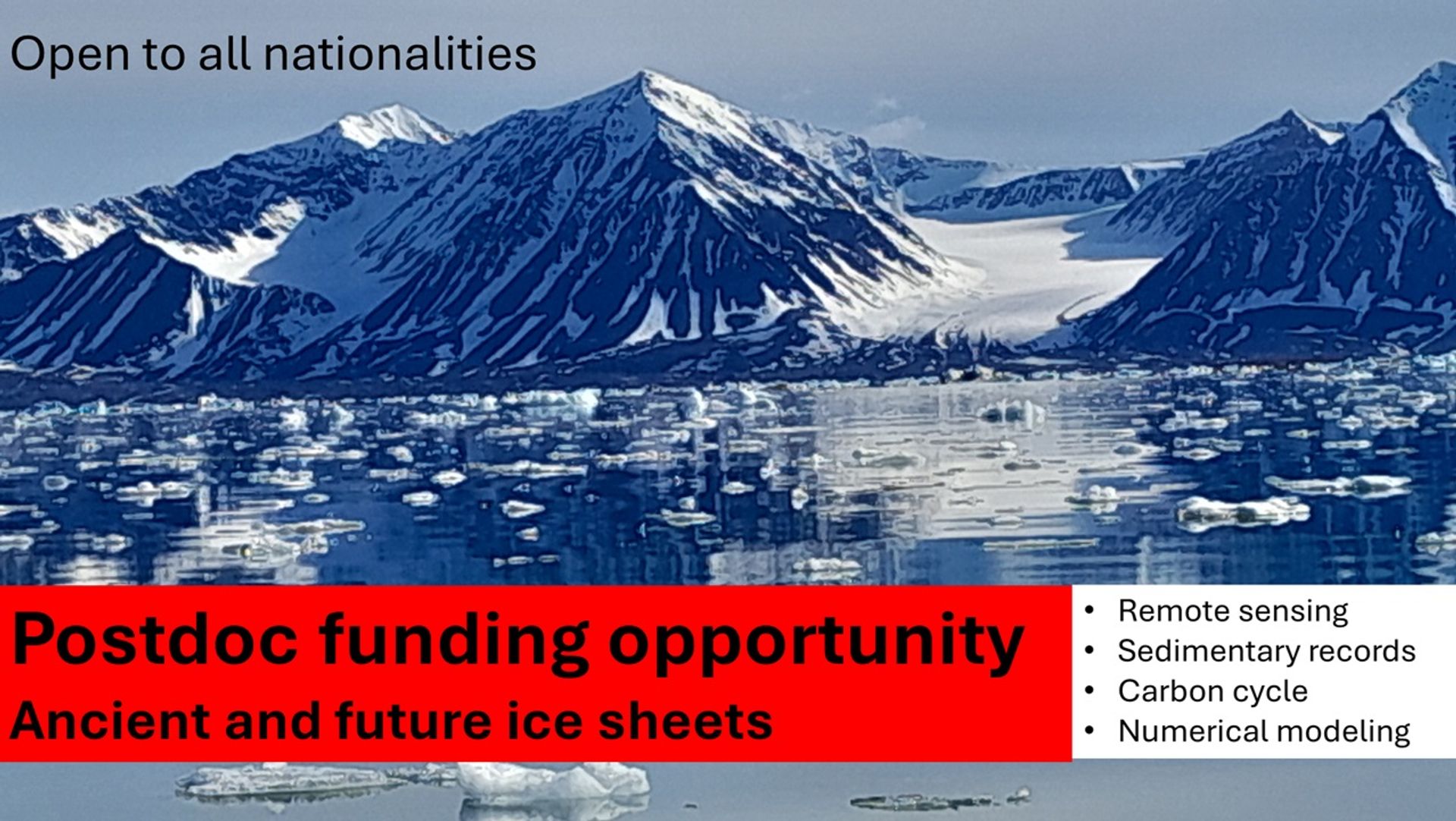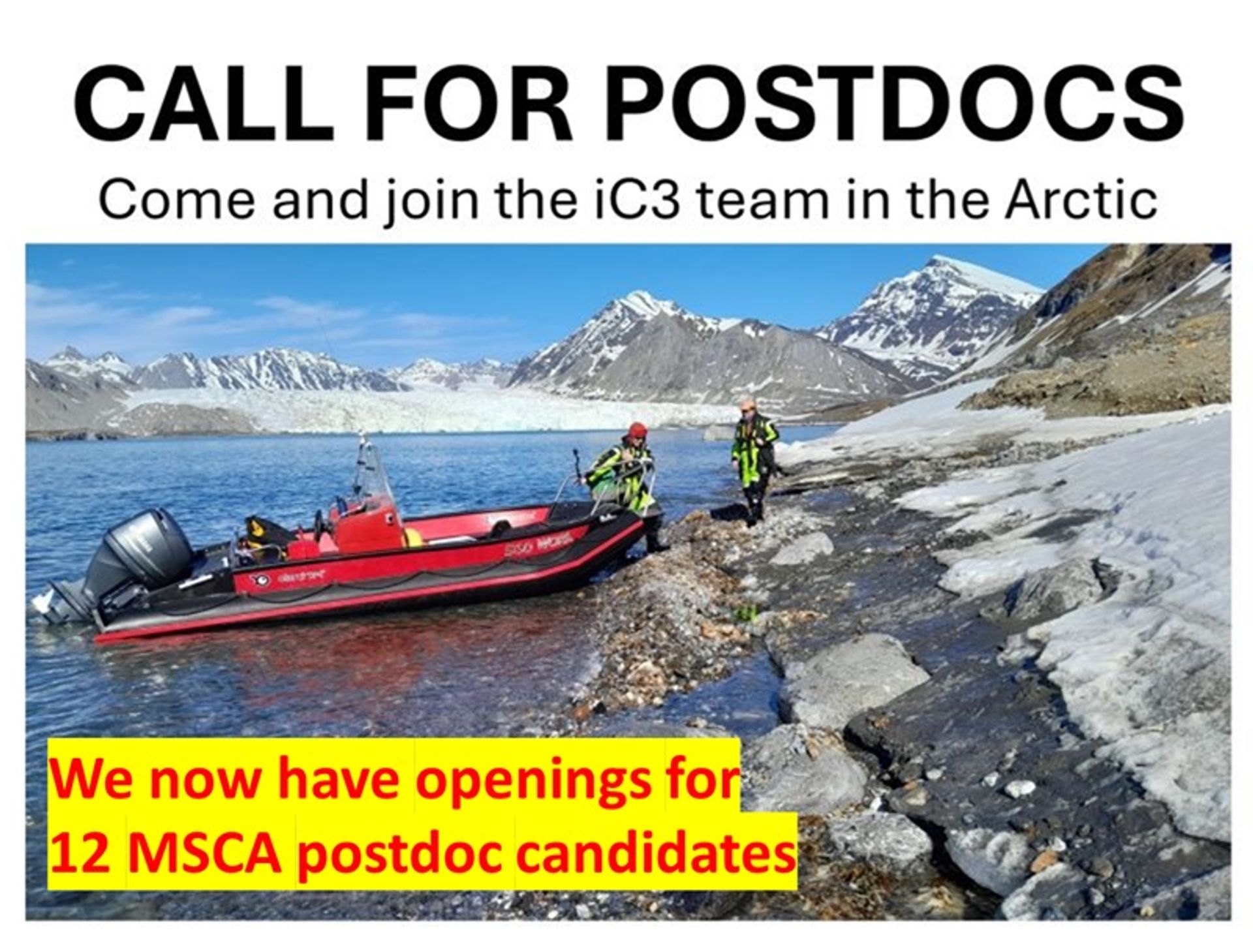Postdoc opportunity: Ancient and future ice sheets
February 5th, 2025
Our colleague Monica Winsborrow is looking for a postdoctoral fellow interested in joining her team to explore glacial changes over long timescales through remote sensing, analysis of sediment records, or numerical modeling. The successful candidate will write an MSCA funding proposal to join iC3’s vibrant community of 25 early career researchers. (See all 12 open postdoc opportunities with iC3 here.)
In this interview, Monica explains how her work contributes to a better understanding of carbon cycling in the polar regions and the impacts of glaciers on the marine ecosystems, and outlines what she is looking for in a postdoctoral collaborator.
.
What's your research area?
The main focus of my research is glacial change. I study how and why ice sheets and glaciers changes over different timescales, the potential drivers behind those changes, and their environmental and climate impacts.
.
Can you give an example?
Sure. A lot of my recent work has focused on the ice sheets that covered the Barents Sea, north of Norway, during the last Ice Age. I’ve been studying how and why that ice sheet disappeared at the end of the Ice Age and what the impacts were on different parts of our global system. For instance, I’ve looked at the release of carbon from the subsurface beneath the seafloor in the Barents Sea.
.
And what did you find out?
We found something quite important. The Barents Sea is a major petroleum province, meaning there are large natural hydrocarbon reserves beneath the seafloor. These hydrocarbon systems were effectively trapped under the massive ice sheets during the last Ice Age. However, as these ice sheets thinned and then retreated completely, large amounts of carbon—particularly methane gas—were released.
This has potential implications for carbon cycling in the area and impacts on the marine ecosystems, including the types of organisms living in the ocean.
.
How do you know it was released thousands of years ago?
Great question—that’s one of the challenges. My work primarily relies on remotely imaged datasets. Since we’re studying areas now covered by the ocean, we conduct research cruises to acquire data by imaging the seafloor, the sediments, and the rock beneath. We also collect sediment samples from the seabed.
What we see are landforms and sediments that indicate large methane releases. For example, in the Barents Sea, we found big craters on the seafloor caused by sudden releases of this trapped methane gas as the ice sheet disappeared at the end of the last Ice Age.
By mapping the seafloor and analyzing these landforms, we can reconstruct how ice sheets behaved in the past and how those ice sheets interacted with the subsurface carbon systems.
.
Is this work driven purely by curiosity, or does it have broader implications?
It’s definitely fascinating work, but it’s also highly relevant. There are likely similar systems beneath the Greenland Ice Sheet today, and parts of Antarctica as well.
By studying what happened thousands of years ago, we can use these findings as an analogue to understand what might happen as the ice sheets in Antarctica and Greenland thin and retreat in similar geological settings—especially in regions with significant carbon and methane reserves currently stored beneath this ice.
.
How does your research link up with the work of other teams within iC3?
At iC3, I work mainly within the research unit that focuses on past analogues of carbon storage and release beneath ice sheets.
Our work aligns well with other iC3 research units because we provide critical information about the processes involved, their relative importance, and the timescales over which they occur. For example, as ice sheets retreat or change, we study the processes that could be triggered, the speed at which they occur, and their potential impacts.
We also collaborate with the modeling teams. They use our data on past systems to improve their models, which helps predict what might happen in the future.
One of the unique aspects of IC3 is our ability to work across timescales. We have researchers studying ice sheets from thousands or even millions of years ago, as well as people focusing on what’s happening today in Greenland and Antarctica, and researchers predicting ice sheet changes in the future. We can track the entire spectrum of ice sheet changes and their associated impacts on carbon cycling.
This also gives us the opportunity to explore how ice sheets interact with different environments. For example, we study how ice sheets interact with the sediments beneath them and follow the processes that transfer the meltwater, nutrients and potential greenhouse gases such as methane, from these ice sheets into the deep oceans.
Covering this full range of interactions is something I find incredibly exciting.
.
What MSCA candidate are you looking for?
There are several ideal profiles. The crucial thing is someone who is passionate about the science and excited to work within the iC3 community, and who can contribute expertise to our team.

I’m particularly interested in candidates who are eager to explore different aspects of glacial change over varying timescales, whether it’s past or future glacial change.
My own expertise lies in remote sensing—both marine and terrestrial—so I’d welcome candidates with similar skills, but complementary expertise is also great.
For instance, we’d value researchers who work with sedimentary records of past ice sheet change and their associated impacts on carbon cycles, or those focusing on numerical modeling of the processes I study empirically.
Ultimately, the most important factor is enthusiasm for science and a willingness to contribute to iC3’s research community.
.
What are the attractions of coming to iC3 as a postdoc?
One of iC3’s key attractions is its multidisciplinary approach. We have glaciologists, biogeochemists, microbiologists, numerical modelers, oceanographers, and researchers studying carbon cycling in the atmosphere.
Having this whole spectrum of expertise right on our doorstep creates an incredibly stimulating and rewarding research environment.
We’re also fortunate to have access to excellent infrastructure at the University of Tromsø. This includes opportunities to join research cruises in Arctic and Antarctic regions aboard Norwegian research vessels. Locally, we have access to Alpine environments and glaciers in northern Norway, along with strong collaborations in Svalbard. These resources allow us to collect unique empirical datasets.
Another strength of IC3 is our supportive environment for early-career researchers. We’ve invested significantly in creating opportunities for career development, and the community here is uniquely supportive.
Lastly, Tromsø itself is an amazing place to live and work—especially if you enjoy outdoor activities. It’s a combination of a vibrant research environment and a beautiful natural setting.
.
If you are interested in applying for an MSCA postdoctoral fellowship with Monica, please read this first and then send her an email briefly outlining your proposed research project and enclose your CV.
The iC3 team will support the selected candidate throughout the process of writing a strong MSCA fellowship proposal. More information on MSCA opportunities with the iC3 Polar Research Hub and our support programme here.
